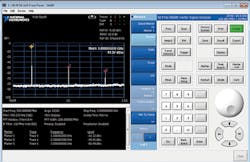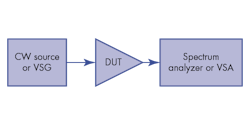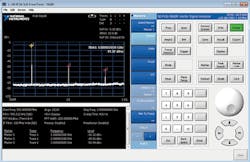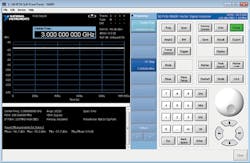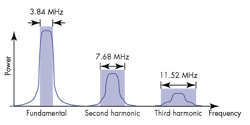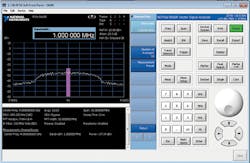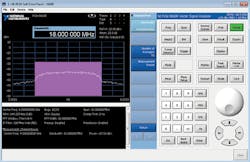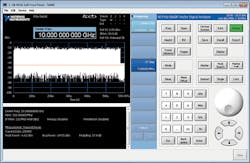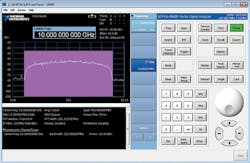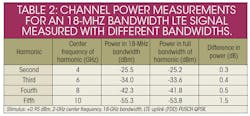This file type includes high resolution graphics and schematics when applicable.
Controlling harmonic energy from communications transmitters is essential for minimizing interference in modern wireless communications systems. As a result, the specifications for wireless standards ranging from 3GPP Long Term Evolution (LTE) and ZigBee to Bluetooth and wireless local area networks (WLANs) each prescribe guidelines governing how much energy a wireless device can emit into specific bands. With any wireless transmitter, one of the most significant sources of unwanted emissions is the result of nonlinear behavior from either the quadrature modulator or the final power-amplifier (PA) stage.
Such nonlinear behavior and its resulting distortion manifest itself in one of two ways: either as signal emissions into frequencies adjacent to the desired operating band, or as emissions at harmonic frequencies of the desired band. The capability to accurately measure the harmonic behavior of these components is critical for certifying a component for use in a modern wireless communications system. Harmonic measurements can be applied to a wide range of components, ranging from modulators and PAs through digital-to-analog converters (DACs) and frequency mixers.
For PAs intended for general-purpose use, harmonic measurements involve the use of a continuous-wave (CW) stimulus. These measurements are fairly straightforward, requiring a signal generator and signal analyzer. The signal generator is set for a CW tone at a desired fundamental frequency and output-power level. The signal analyzer measures the output power from a device under test (DUT) at multiples of the input frequency. Common harmonic measurements occur at the second, third, fourth, and fifth harmonic frequencies.
Using an RF/microwave vector signal analyzer (VSA), several techniques are available for measuring the output power of signal harmonics. These involve either the frequency or time domain, with tradeoffs in simplicity, measurement time, and accuracy depending upon the choice of measurement approach.
One of the simplest techniques is to measure signal output power at the predicted frequency of the harmonic of interest, based on the fundamental frequency. For instruments providing the function, a peak search can be performed to determine the harmonic output power of a DUT.
For example, a DUT being fed a fundamental tone at 1 GHz will generate a third-harmonic tone at 3 GHz (Fig. 1). With this approach, several harmonics can be measured in a single test sweep, provided that the start and stop frequencies of the signal analyzer are configured appropriately. This harmonic-measurement technique is simple, but it can be quite time consuming in automated test applications. Other harmonic measurement methods trim measurement time by focusing on measuring power only in the band of interest.
A second method for measuring harmonic power involves a VSA’s zero-span measurement mode. In this mode, often called the transmit power (TxP) measurement mode, a VSA measures power as the magnitudes of in-phase (I) and quadrature (Q) signal samples at a single frequency. In zero-span mode, the signal analyzer effectively performs a series of “channel power” measurements and displays the results as a function of time. In this mode, the bandwidth of the power measurement is configured by setting the resolution bandwidth of the signal analyzer.
When using the TxP measurement approach, the acquisition duration operates as a built-in averaging function for the measurement. In fact, because measurement uncertainty is heavily influenced by periodic factors such as noise, a longer measurement time window will result in improved measurement uncertainty. When using these first two measurement approaches, the results for third-harmonic measurements are nearly identical (Figs. 2 and 3), although the time-domain approach is much faster.
Harmonic measurements performed on RF/microwave components designed for a particular wireless standard start with a modulated stimulus. The wide bandwidths of newer standards such as IEEE 802.11ac and LTE Advanced (LTE-A) require wideband signal analyzers such as a VSA to demodulate fundamental-frequency waveforms and measure the power of wideband harmonic signals. The nature of a wireless standard will determine which measurement techniques to use for harmonic measurements, either in the time or frequency domains.
Some wireless standards, such as 3GPP LTE and IEEE 802.11ac WLAN, do not specifically prescribe a harmonic requirement. Rather, they specify maximum spurious emission requirements over a range of frequencies. For example, 3GPP LTE requires that an LTE transmitter not emit power exceeding -30 dBm within a 1-MHz bandwidth at frequencies over 1 GHz. Validating that an RF device does not cause a transmitter to exceed this requirement calls for measurements of emissions in a 1-MHz bandwidth at harmonic frequencies of interest.
When characterizing the harmonic behavior of an LTE PA, an assessment is being made of the likelihood that the PA’s harmonics will cause a mobile device to violate the standard’s spurious emissions requirements. A range of methods can be applied to ensure that the PA does not violate those spurious emissions requirements. In a research and development or characterization laboratory, it is common for engineers to measure spurious emissions directly by performing a series of channel power measurements in the prescribed measurement bandwidth.
However, in a manufacturing environment where test time is critical, it is more common to measure the power of the harmonic directly. Statistical correlation can then be used to predict whether an RF/microwave component will violate a standard’s spurious emissions requirements.
Measuring the harmonics of modulated signals requires careful attention to the measurement bandwidth. The required measurement bandwidth of a harmonic changes as a function of the harmonic. For example, when testing the output harmonics of an RF/microwave device that requires a measurement bandwidth that is N-MHz wide, the measurement bandwidth of the third harmonic must be 3N MHz; the measurement bandwidth of the fifth harmonic must be 5N MHz (Fig. 4).
Harmonics can be measured in the time or frequency domain, depending upon the instantaneous bandwidth of a signal analyzer and whether or not bursted stimulus signals are being used. One measurement shortcut worth considering is to measure the harmonic power in a bandwidth equivalent to the system channel bandwidth.
For example, although the bandwidth of an 18-MHz LTE signal’s third harmonic is 54 MHz, the majority of the power will be contained in the initial 18-GHz channel bandwidth. With the primary motivation for LTE harmonic measurements being to determine whether a PA will violate the standard’s spurious emissions requirement, the partial-bandwidth measurement method captures energy in the bandwidth most likely to influence spurious emissions.
The maximum permissible emissions of a cellular transmitter is -30 dBm in a 1-MHz bandwidth (Table 1). In example measurements of an LTE PA’s second harmonics at 4 GHz (Fig. 5), the integrated power in a 1-MHz bandwidth in the center of the band is -37 dBm, or 7 dB below the LTE spurious emissions requirement. However, the integrated power in 18 MHz bandwidth is -27 dBm, or 3 dB higher than the LTE maximum, although the measurement bandwidth is much greater.
Furthermore, the integrated power in the full harmonic bandwidth would be slightly higher. As this case shows, it is often possible to determine the likelihood that a PA will meet a wireless standard’s spurious emissions requirements by measuring harmonic power in the same bandwidth as the fundamental frequency. In many cases, the power difference between the harmonic power in the full bandwidth and the harmonic power in the partial bandwidth is quite small.
Table 2 compares the power of the harmonic in 18 MHz bandwidth and the power integrated across the full bandwidth of the harmonic. The results illustrate that the difference in power between the two measurement bandwidths increases with the order of the harmonic frequency. It is noteworthy that, for the fifth harmonic, the power in 18 MHz bandwidth is 1.5 dB lower than the power in the full harmonic bandwidth of 90 MHz.
For harmonic measurements of bursted signals, such as for IEEE 802.11ac, time-domain measurements using zero-span mode are preferable but not always realistic. For example, accurately measuring the third harmonic of a 160-MHz IEEE 802.11ac signal requires 480 MHz instantaneous bandwidth.
In some instances, the harmonics of a bursted signal can be measured in the frequency domain, but the method requires calculations for a bursted stimulus. In such a case, a channel-power (ChP) measurement can be used to record the integrated power in the desired band, with the duty cycle of the waveform included in the calculations for an accurate assessment of the harmonic power. For example, for a signal that is on “n” percent of the time, a power offset of 20log(n/100) must be calculated.
Figure 6 illustrates harmonics measurements in both the time and frequency domain of a signal with an 85% duty cycle. Given that 20log(0.85) equals -1.41 dB, 1.41 dB must be added to a harmonic measurement performed in the frequency domain to account for the bursted signal’s duty cycle. Accounting for duty cycle is relatively straightforward when the duty cycle is high, but is subject to error when the duty cycle is low. Because this measurement technique requires power measurements even when a signal is not present, the additive noise of a signal during its “dead” or off periods can potentially skew the final measurement result.
Although harmonic measurements can be performed in either the frequency or time domain, an important tradeoff in automated testing is measurement accuracy versus measurement time. Especially for higher-order harmonics, noise is a significant source of measurement uncertainty. Fortunately, uncertainty due to noise is mitigated by performing measurements over a larger number of samples—either by applying averaging or increasing the measurement time window.
Traditional swept-frequency spectrum analyzers define sweep time as the duration over which a specified frequency span is swept by the analyzer’s analog resolution-bandwidth (RBW) filter. The accuracy of the measurement depends on the duration for which the RBW filter stays in a particular frequency range. VSAs based on Fast-Fourier-Transform (FFT) techniques digitally process signals using an FFT, followed by digital RBW filtering to obtain the measured spectrum. In this approach, the sweep time is interpreted as the signal acquisition time.
In the time domain, zero-span measurements display an instantaneous power trace as seen through an RBW filter. In this mode, the RBW specifies the acquisition bandwidth and cannot exceed the signal analyzer’s maximum instantaneous bandwidth. In theory, time-domain power measurements using a transmit-power (TxP) measurement should be significantly faster than a ChP measurement, since the TxP approach does not require converting signals from the time domain to the frequency domain.
To illustrate this point, Fig. 7 compares measurement time and measurement repeatability when measuring the power of the third harmonic of a WLAN signal. The harmonic bandwidth is 480 MHz; testing is performed on a model PXIe-5668R VSA from National Instruments, with more than 750 MHz instantaneous bandwidth. The measurement time is the time taken for the VSA to acquire data and return a power measurement for a particular sweep time.Measurement repeatability is measured by taking the standard deviation of 100 measurements. For both measurement techniques, measurement repeatability improves by increasing the measurement window or sweep time. However, when using the TxP measurement approach, more repeatable measurement results are achievable in much less test time. For example, a ChP measurement that is designed to achieve 0.1-dB repeatability requires 2 s, while a TxP measurement for the same repeatability occurs in less than 50 ms.
Measuring the harmonics of essential communications system components, such as PAs or modulators, ensures that a final product using those components does not generate unwanted emissions in violation of a particular wireless standard. When seeking an optimal approach for measuring harmonics, a number of factors should be considered, including measurement time, accuracy, repeatability, bandwidth, and a signal’s behavior. By weighing the strengths and weakness of different measurement methods, a user can achieve good results with a VSA, meeting the harmonic test needs of many different wireless standards.
Vimal M. Fernandez
Product Marketing Manager, RF and Microwave Test, National Instruments, Inc.
This file type includes high resolution graphics and schematics when applicable.
